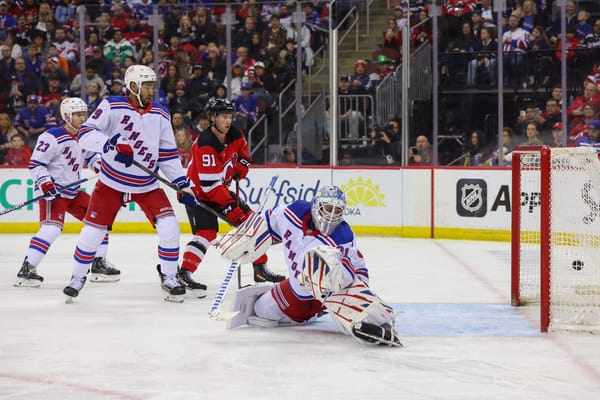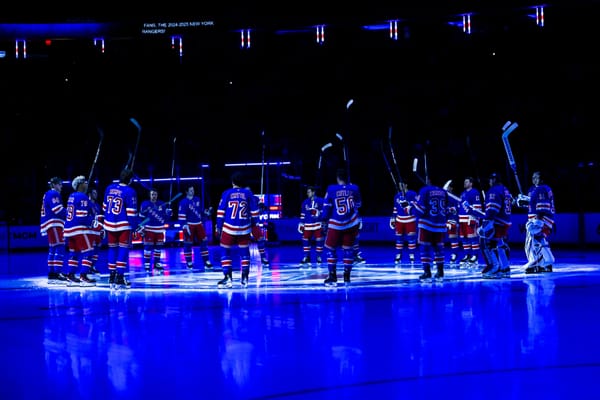2017 Rangers Report Card: Brendan Smith
Brendan Smith only played 18 regular season games and 12 playoff games in a New York Rangers’ sweater, but in that time he certainly made an impact.
Just prior to the 2017 trade deadline, Smith was acquired from the Detroit Red Wings in exchange for a 2017 third-round pick and 2018 second-round pick (from the Ottawa Senators that the Rangers received in the Mika Zibanejad trade). The Rangers defense struggled throughout the season, so general manager Jeff Gorton sought out Smith to strengthen the blue line. Although left-handed, Smith provided the stability the Rangers craved on the right side.
While with the Red Wings, Smith showed his willingness to jump up in the play to contribute to the offense, along with strong skating and puck moving abilities. In the past his high-risk offensive plays were sometimes at the expense of defensive positioning. As a result Smith had to adjust his game.
Gorton brought Smith in to address the many needs of the Rangers blue line, including more reliable play in the defensive zone. The players who the Rangers perceived to be a shutdown presence (namely Dan Girardi), were largely ineffective in that role.
Although it was a small sample, Smith excelled in that role. In his 18 regular season games in New York, he earned one goal and three assists – comparatively, he had five points (two goals, three assists) in his 33 regular season games with the Red Wings before the trade.
Smith played the highest 5-on-5 ice time of any other player on the Rangers after he was acquired (313.67 minutes). He was used in several different roles on the blue line, including an appearance on the top pair.
Smith brought offense to the Blueshirts’ blue line.
All four of his points in New York were scored at 5v5 (0.77 points per 60). Additionally, all four points were primary points scored (0.19 primary points per 60). His points per 60 and primary points per 60 were not particularly impressive compared to the other Rangers’ blue liners because he played the most ice time, but were nonetheless noteworthy.
During the regular season, he was paired with Nick Holden the most (161.37 minutes of 5v5), as well as Ryan McDonagh (48.17 minutes), Brady Skjei (47.35 minutes) and Girardi (42.97 minutes) – before becoming a fixture on a pair with Skjei in the playoffs.
Smith’s on ice offensive generation was fairly low, especially when he was not paired with Skjei. Compared to the rest of the Rangers defense (between February 28 and April 9, the time after the deal), Smith’s possession numbers were somewhat unremarkable (as evidenced by his low 51.84 Corsi for per 60 and 6.69 scoring chances for per 60). However, his goals for per 60 (2.3) was the third-highest on the Rangers blue line.
But of course Smith’s game isn’t about counting stats.
In that 18 game span at the tail end of the season, Smith had a Corsi against per 60 of 54.13 – that Staal (58.64), Holden (60.84), McDonagh (69), and Girardi (76.22) all exceeded. He suppressed the most scoring chances against (8.8 scoring chances against per 60) and had the second lowest expected goals against per 60 (2.46, trailing only Skjei’s 2.36). Additionally, Smith was on the ice for very few goals against (1.72 goals against per 60, the second lowest of the defense).
In other words he was just what the Rangers needed.
Smith continued his strong play into the postseason and emerged as a key player for the Rangers. He earned four assists (all at 5v5, three primary and one secondary; third highest in points for the Rangers defense, behind McDonagh and Skjei).
His postseason can be highlighted by his low Corsi against per 60 of 57.37 (lowest on the defense), 28.24 shots against per 60 (lowest on defense), 3.57 goals for per 60 (second highest on defense), and 1.19 goals against per 60 (lowest on defense).
Also, Smith was the most effective defenseman in limiting high-danger shot attempts and goals against, in addition to being on the ice for a number of high-danger shot attempts and goals for (56.92 high-danger Corsi for percentage, 77.78 high-danger goals for percentage – both the highest on defense).
He was a calming presence in the defensive zone and good things happened for the Rangers when he was on the ice.
Really, the only complaint that can be made about Smith’s play in the postseason was that he did not receive enough ice time. Head coach Alain Vigneault favored the pair of Holden and Staal, who often had dismal results, over Skjei and Smith. But Smith’s usage certainly cannot be used against him.
Whether or not Smith is re-signed should not be an indictment of his play in either the regular or postseason, since he proved to be worth what the Rangers gave up to land him. Really the cost of bringing him to New York should have earned him more ice time by default, but that is no fault of his.
Based on Smith’s on ice actions and only his actions – between his exceptional defensive play, glimpses of offense, and the element of physicality he brought to the team, Smith’s performance as a member of the Rangers merits an overall grade of an A-.
*Data is at 5v5, via Corsica.hockey and NaturalStatTrick.




